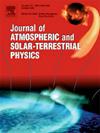行星边界层方案对理想热带气旋最大潜在强度的影响
IF 1.9
4区 地球科学
Q3 GEOCHEMISTRY & GEOPHYSICS
Journal of Atmospheric and Solar-Terrestrial Physics
Pub Date : 2025-08-05
DOI:10.1016/j.jastp.2025.106603
引用次数: 0
摘要
热带气旋的发展依赖于边界层过程。随着气候变化的加剧,在不同的行星边界层方案下预测极端tc的强度至关重要。本研究利用天气研究与预报(WRF)模式中云分辨分辨率下的理想TC实验,采用低阶或高阶闭合PBL方案,以及本地或非本地类型,研究这些方案对TC最大潜在强度(MPI)的影响。结果表明,MPI对PBL方案的选择非常敏感,模拟MPI的差异可达67 hPa。虽然不同闭合方法的方案通常计算湍流扩散系数不同,但一些方案,如YSU和MYNN3,由于共享低边界层高度(PBLH)和有效的潜热利用,模拟了相似的MPI。相反,具有相似扩散系数定义的方案,如MYNN3和BouLac,由于混合机制的不同,可以产生不同的MPI。强TC与弱TC的对比分析表明,强TC的边界层高度较低,湍流扩散系数峰值离地面更远,导致近地面梯度风不平衡更大,径向入流更强。另一方面,弱tc边界层高度较高,峰值更靠近地面,导致流入较弱。强TC的强入流促进了核心区水汽辐合,增强了核心区内部的绝热加热,形成了明显的上层暖核,加速了TC的增强。研究强调了PBL方案如何通过连接动力和热力学过程显著影响TC MPI。本文章由计算机程序翻译,如有差异,请以英文原文为准。
The impacts of planetary boundary layer schemes on maximum potential intensity of idealized tropical cyclone
Tropical cyclones (TCs)' development relies on boundary layer processes. With climate change increasing extreme TCs, predicting their intensity under different planetary boundary layer (PBL) schemes is crucial. This study utilizes idealized TC experiments at cloud-resolving resolution within the Weather Research and Forecasting (WRF) model, employing PBL schemes of low-order or high-order closure, and local or nonlocal types, to investigate the impacts of these schemes on TC's maximum potential intensity (MPI).
The findings indicate that the MPI is remarkably sensitive to the choice of PBL schemes, with disparities in simulated MPI reaching up to 67 hPa. While schemes with different closure methods often compute turbulent diffusion coefficients differently, some, like YSU and MYNN3, simulate similar MPI due to shared low boundary layer heights (PBLH) and efficient latent heat utilization. Conversely, schemes with similar diffusion coefficient definitions, such as MYNN3 and BouLac, can produce differing MPI due to variations in mixing mechanisms.
Analysis of strong versus weak TC simulations reveals that strong TCs have lower boundary layer heights and turbulent diffusion coefficient peaks further from the surface, leading to greater near-surface gradient wind imbalance and stronger radial inflow. Weak TCs, on the other hand, have higher boundary layer heights and peaks closer to the surface, resulting in weaker inflow. Stronger inflow in strong TCs promotes moisture convergence in the core region, enhancing inner-core diabatic heating and forming a pronounced upper-level warm core, which accelerates TC intensification. The study highlights how PBL schemes significantly affect TC MPI by linking dynamic and thermodynamic processes.
求助全文
通过发布文献求助,成功后即可免费获取论文全文。
去求助
来源期刊

Journal of Atmospheric and Solar-Terrestrial Physics
地学-地球化学与地球物理
CiteScore
4.10
自引率
5.30%
发文量
95
审稿时长
6 months
期刊介绍:
The Journal of Atmospheric and Solar-Terrestrial Physics (JASTP) is an international journal concerned with the inter-disciplinary science of the Earth''s atmospheric and space environment, especially the highly varied and highly variable physical phenomena that occur in this natural laboratory and the processes that couple them.
The journal covers the physical processes operating in the troposphere, stratosphere, mesosphere, thermosphere, ionosphere, magnetosphere, the Sun, interplanetary medium, and heliosphere. Phenomena occurring in other "spheres", solar influences on climate, and supporting laboratory measurements are also considered. The journal deals especially with the coupling between the different regions.
Solar flares, coronal mass ejections, and other energetic events on the Sun create interesting and important perturbations in the near-Earth space environment. The physics of such "space weather" is central to the Journal of Atmospheric and Solar-Terrestrial Physics and the journal welcomes papers that lead in the direction of a predictive understanding of the coupled system. Regarding the upper atmosphere, the subjects of aeronomy, geomagnetism and geoelectricity, auroral phenomena, radio wave propagation, and plasma instabilities, are examples within the broad field of solar-terrestrial physics which emphasise the energy exchange between the solar wind, the magnetospheric and ionospheric plasmas, and the neutral gas. In the lower atmosphere, topics covered range from mesoscale to global scale dynamics, to atmospheric electricity, lightning and its effects, and to anthropogenic changes.
 求助内容:
求助内容: 应助结果提醒方式:
应助结果提醒方式:


